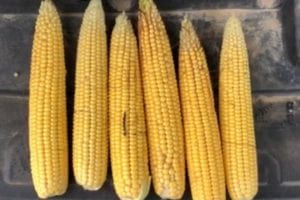 According to the latest Ohio Crop Weather Report 90% of the Ohio corn crop is in the dough stage, 3 percentage points ahead of the 5-year average. 40% of the crop is in the dent stage 10% below the 5 year average.
According to the latest Ohio Crop Weather Report 90% of the Ohio corn crop is in the dough stage, 3 percentage points ahead of the 5-year average. 40% of the crop is in the dent stage 10% below the 5 year average.
This time of year many of us begin to think about our potential corn yield. The most popular yield estimator is the THE YIELD COMPONENT METHOD. This procedure was developed by the Agricultural Engineering Department at the University of Illinois. The yield component method involves use of a numerical constant for kernel weight which is figured into an equation in order to calculate grain yield. This numerical constant is sometimes referred to as a “fudge‑factor” since it is based on a predetermined average kernel weight. Since weight per kernel will vary depending on hybrid and environment, the yield component method should be used only to estimate relative grain yields, i.e. “ballpark” grain yields. When below normal rainfall occurs during grain fill (resulting in low kernel weights), the yield component method will OVERESTIMATE yields. In a year with good grain fill conditions (resulting in high kernel weights) the method will underestimate grain yields.
In the past, the YIELD COMPONENT METHOD equation used a “fudge factor” of 90 (as the average value for kernel weight, expressed as 90,000 kernels per 56 lb bushel), but kernel size has increased as hybrids have improved over the years. Assuming no stress during grain fill, a “fudge factor” of 80 to 85 (85,000 kernels per 56 lb bushel) is a more realistic value to use in the yield estimation equation today.
Step 1. Count the number of harvestable ears in a length of row equivalent to 1/1000th acre. For 30‑inch rows, this would be 17 ft. 5 in.
Step 2. On every fifth ear, count the number of kernel rows per ear and determine the average.
Step 3. On each of these ears count the number of kernels per row and determine the average. (Do not count kernels on either the butt or tip of the ear that are less than half the size of normal size kernels.)
Step 4. Yield (bushels per acre) equals (ear #) x (avg. row #) x (avg. kernel #) divided by 85.
Step 5. Repeat the procedure for at least four additional sites across the field. Keep in mind that uniformity of plant development affects the accuracy of the estimation technique.
The more variable crop development is across a field, the greater the number of samples that should be taken to estimate yield for the field.
Example: You are evaluating a field with 30‑inch rows. You counted 32 ears (per 17′ 5″ = row section). Sampling every fifth ear resulted in an average row number of 16 and an average number of kernels per row of 33. The estimated yield for that site in the field would be (32 x 16 x 33) divided by 85, which equals 199 bu/acre.
